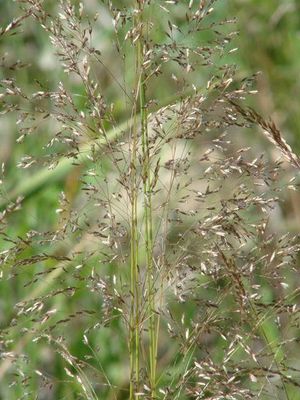Deschampsia cespitosa
- Scientific Name: Deschampsia cespitosa
- Family: Poaceae
- Common Names: Bering hair grass, Pacific hair grass, tufted hair grass, Beringian hairgrass, tufted hairgrass
- Synonyms/Misapplications: Aira caespitosa, Aira holciformis, Deschampsia beringensis, Deschampsia caespitosa, Deschampsia glauca, Deschampsia holciformis
- Codon: DESCES
Contents
Taxonomy
| Scientific classification | |
|---|---|
| Kingdom: | Plantae |
| Subkingdom: | Viridiplantae |
| Phylum: | Tracheophyta |
| Subphylum: | Spermatophytina |
| Class: | Magnoliopsida |
| Subclass: | Lilianae |
| Order: | Poales |
| Family: | Poaceae |
| Genus: | Deschampsia P. Beauv. |
| Species: | Deschampsia cespitosa (L.) P. Beauv. |
| Synonyms | |
| |
Description
Perennial, densely cespitose bunchgrass with culms to 120 cm tall[2] and open to contracted panicles.[3] Leaf sheaths open, glabrous to scabrous; ligules greater than 4 mm long, pubescent, sometimes split;[4] blades often flat,[3] to 33 cm long and 1-4 mm wide.[2] Panicles to 25 cm long; spikelets shiny, purplish, 2 to 3-flowered;[4] Lemmas 2.5-4 mm long,[4] 5-nerved, glabrous, smooth, glistening[3], awned toward base;[2] lower glumes 1-nerved[4] 2.7-7 mm long[4], upper glumes 3-nerved,[4] 2-7.5 mm long.[3] Paleas shorter than lemmas.[4] The fruit is a caryopsis.[2]
Bloom Period
June-September[4]
Distribution
Widely distributed across Washington; Alaska to California, east across North America.[4]
Habitat
Low to high elevation wetlands, wet meadows and shores to dry, open forests.[3]
Uses
Frequently eaten by bears, Sitka black-tailed deer and feral horses. Umber Skipper nectar source and larval host.[2]
First Nations people report that seeds of Deschampsia species have been eaten by indigenous peoples of California and Utah.[5]
Propagation
Tufted hairgrass can be grown for seed on well drained medium to fine textured soils on uplands as well as on poorly-drained silts and clays in low lying areas. If seasonally flooded areas are to be used for seed production, fields must be firm enough to perform weed control measures and dry enough to windrow and harvest by as early as mid-June (western Oregon). This species is broadly adapted to soils that are acid to neutral (pH 4.5-7.0).[6]
Good results from fall sowing. In a nursery, sow in containers in April on heat (night -15º C, days 20-24º C), germination in 30 days. Cover lightly with soil and screen until germination occurs. Plugs form slowly in about 60 days if kept continually moist and at a constant temperature (S. Bastin, pers. comm.).
Can be very aggressive. Leave room to spread or control in place. Doesn't tolerate transplanting unless well-rooted (S. Bastin, pers. comm.).
Native Plant Network Propagation Protocol
Seed
Average Measurement with husk/awn: 3.4 x 0.8 x 0.8
Average Measurement without husk/awn: 1.8 x 0.6 x 0.6
Measurement Range with husk/awn: L: 2.5 – 4.5, W: 0.5 – 1, D: 0.6 – 1
Measurement Range with husk/awn: L: 1.5 – 2, W: 0.5 – 0.75, D: 0.5 – 0.6
Features
Shape: Seed narrow at hilum and opposite apex, rounded in the middle.
Additional Structures: Lemma thin, and have several nerves running across them. Awn originates from the hilum and is about 1 ½ times the length of the seed body. Hilum bearded with feather like appendage. Palea also thin.
Color: Tan palea and lemma, awn slightly darker brown. Inner seed red-brown, and somewhat transparent.
Surface: Seed finely longitudinally striate and lustrous. Awn finely barbed.
Latitudinal Cross Section: elliptical 
Longitudinal Cross Section: elliptical ![]()
Photo Gallery
References
- http://plants.usda.gov/java/profile?symbol=DECE
- http://biology.burke.washington.edu/herbarium/imagecollection.php
- http://www.wildflower.org/plants/result.php?id_plant=DECE
- http://www.fs.fed.us/database/feis/plants/graminoid/desces/introductory.html
- ↑ Integrated Taxonomic Information System. Retrieved from https://www.itis.gov/servlet/SingleRpt/SingleRpt?search_topic=TSN&search_value=502001
- ↑ 2.0 2.1 2.2 2.3 2.4 USFS Fire Effects Information System. Retrieved from https://www.fs.fed.us/database/feis/plants/graminoid/desces/all.html
- ↑ 3.0 3.1 3.2 3.3 3.4 Hitchcock, C. L., Cronquist, A., Giblin, D., & Legler, B. et al. (2018). Flora of the Pacific Northwest: an illustrated manual. Seattle: University of Washington Press. p. 789.
- ↑ 4.0 4.1 4.2 4.3 4.4 4.5 4.6 4.7 4.8 WTU Herbarium, Burke Museum, & University of Washington. Retrieved from http://biology.burke.washington.edu/herbarium/imagecollection/taxon.php?Taxon=Deschampsia%20cespitosa
- ↑ Native American Ethnobotany Database. Retrieved from http://naeb.brit.org/uses/12331/
- ↑ USDA Plant Guide. Retrieved from https://plants.usda.gov/plantguide/pdf/pg_deca18.pdf


